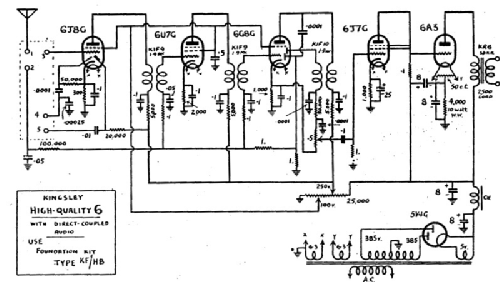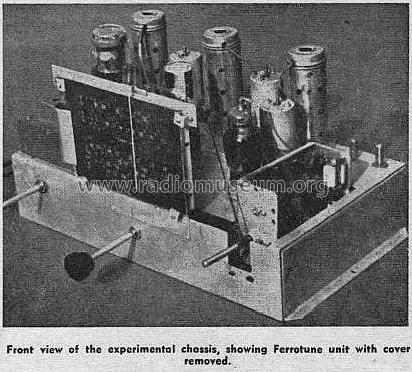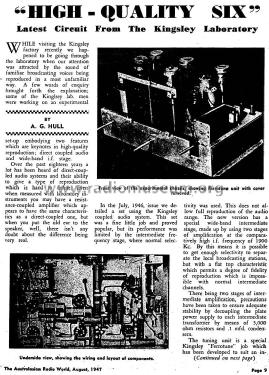High Quality Six (6)
Kingsley (brand); various manufacturers
- Pays
- Australie
- Fabricant / Marque
- Kingsley (brand); various manufacturers
- Année
- 1947
- Catégorie
- Radio - ou tuner d'après la guerre 1939-45
- Radiomuseum.org ID
- 251623
Cliquez sur la vignette du schéma pour le demander en tant que document gratuit.
- No. de tubes
- 6
- Principe général
- Super hétérodyne (en général); FI/IF 1900 kHz; 3 Etage(s) BF; Appareillage spécial ? Renseignements souhaités SVP.
- Circuits accordés
- 7 Circuits MA (AM)
- Gammes d'ondes
- PO uniquement
- Tension / type courant
- Alimentation Courant Alternatif (CA) / 240 Volt
- Haut-parleur
- HP dynamique à aimant permanent + bobine mobile
- De Radiomuseum.org
- Modèle: High Quality Six - Kingsley brand; various
- Remarques
-
6 Valve, AC powered superhet with a wide band IF centred on 1900kHz and a direct coupled audio output stage.
This was an experimental kit set for home construction designed by A.G. Hull.
It was supplied with a Kingsley KFJB "Ferrotune" permeability tuning unit and IF transformers set up in the factory to match the 1900kHz IF.
The audio stage was based on the” Loftin White” principal.
The audio stage uses direct DC coupling. The 6J7G with the plate, screen and suppressor tied together to form a triode is the first audio stage. The plate is tied direct to the grid of output triode 6A3. See the schematic. Actual voltage on the plate and grid is about 100V. In order to arrange correct bias for the output valve the filament circuit is set at 130V. This is achieved by using a power transformer with a separate filament winding for the output stage and a 4k resistor to earth. The bias voltage is then developed between the grid and filament. With respect to earth the grid is 30V negative.
- Littérature
- -- Original prospect or advert (Australasian Radio World Aug 15, 1947 Page 9.)
- Schémathèque (1)
- -- Original prospect or advert (Australasian Radio World Aug 15, 1947 Page 11.)
| Australasian Radio World Aug 15, 1947 Page 9 & 11. | 426 KB |
- Documents sur ce modèle
- Auteur
- Modèle crée par Gary Cowans. Voir les propositions de modification pour les contributeurs supplémentaires.
- D'autres Modèles
-
Vous pourrez trouver sous ce lien 94 modèles d'appareils, 32 avec des images et 14 avec des schémas.
Tous les appareils de Kingsley (brand); various manufacturers


